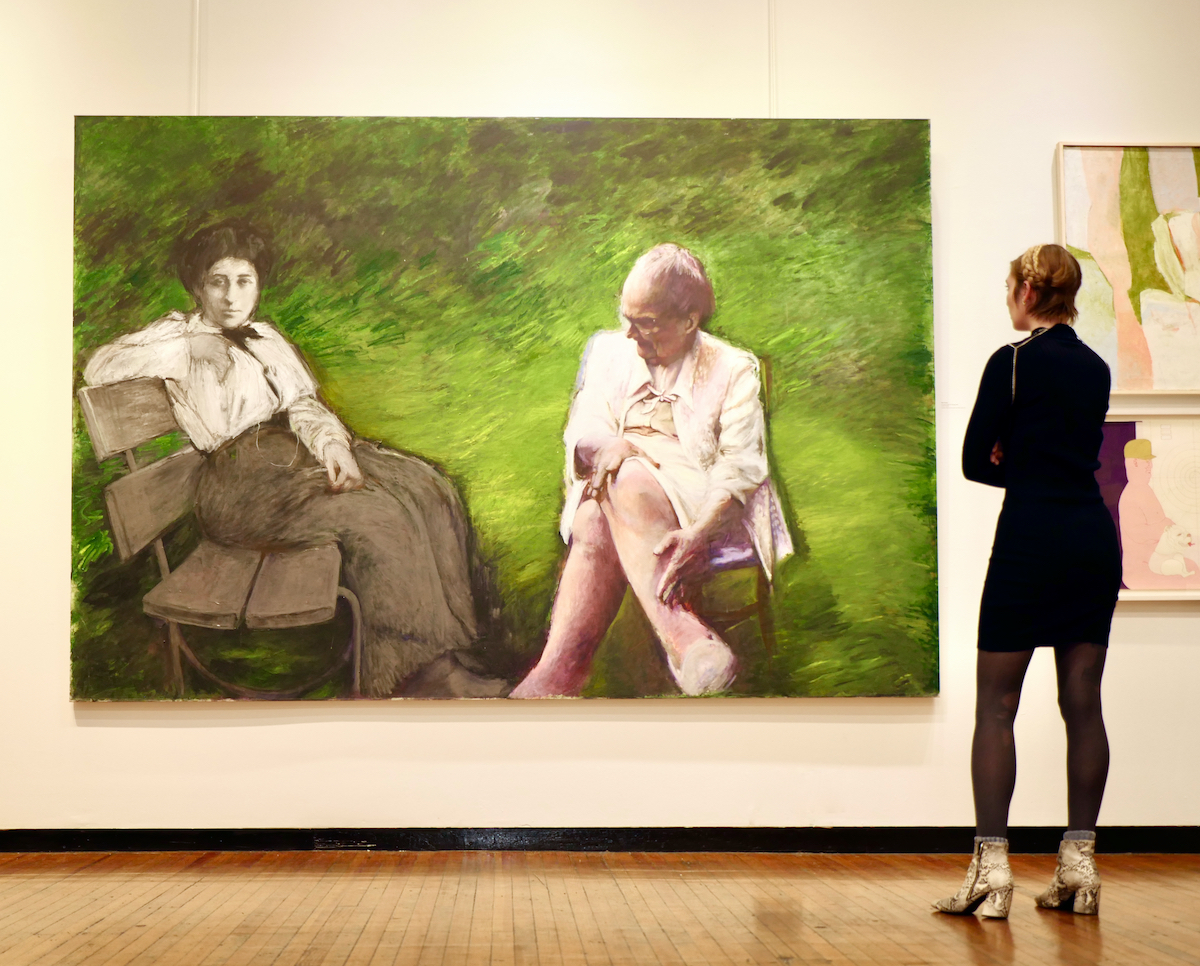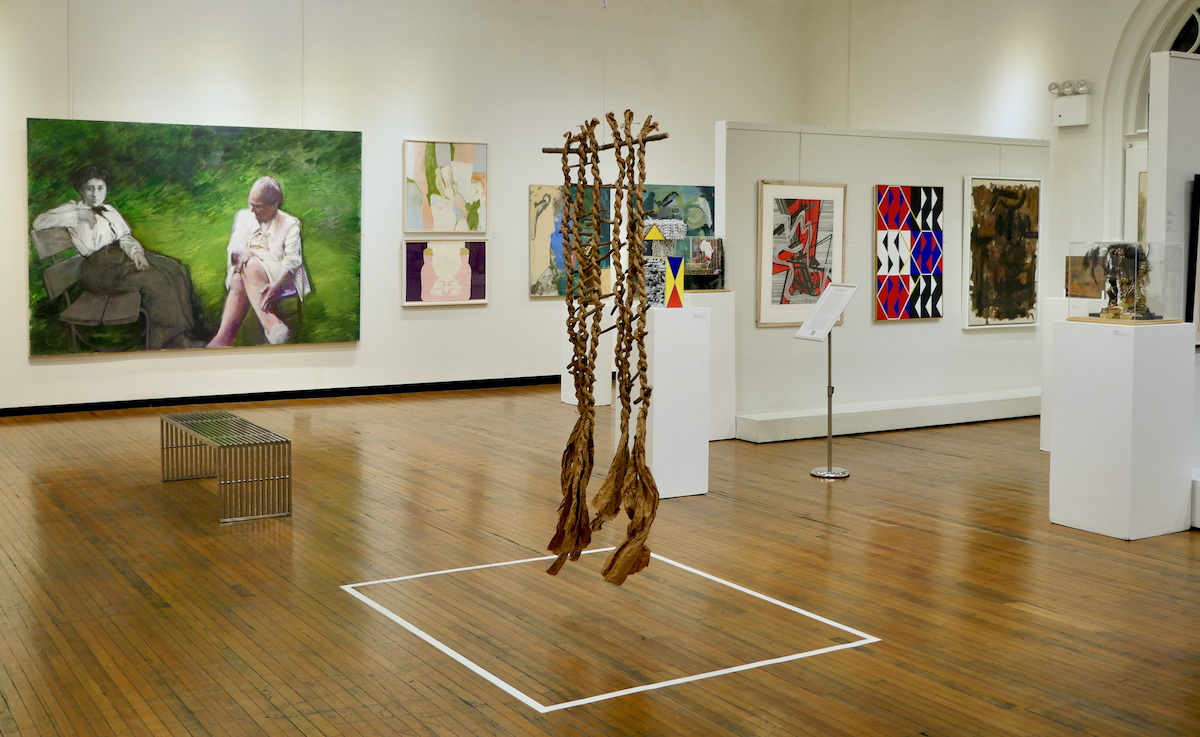 [1]
[1]Entering this exhibition is like going back in time: the works are not exactly hung salon-style – there is just one row – but they are arranged very densely, with several sculptures placed on the school gallery’s old floor boards. The layout conveys the spirit and the history of the venue. Works by forty three of many women who studied from 1945-65 at The Art Students League are shown where they drew, painted and talked some sixty years ago. The presence of only six of them at the opening reminds how timely this recognition is.
Just as the League has traditionally admitted students from all walks of life and provided them with varied instructors to choose from a constellation of autonomous studios, curator William Corwin cast his net wide: while the majority of the artists in the show are modernists and abstract painters and sculptors, abstract expressionists make up only one fourth of the artists, and pluralism – of styles, mediums, and cultural backgrounds – is a great merit of the show.
Postwar Women includes works by household names such as Helen Frankenthaler, Grace Hartigan, Lee Krasner, Elaine de Kooning, and Maria Helena Vieira da Silva, and by less known artists like Perle Fine who is represented not only by a 1952 oil, typical for her oeuvre, but also a bold collage abstracting letters and possibly aiming at the deconstruction of language (Collage #2, 1965). Among rarities is a delicate, sophisticated composition by Czech-born Terry Haass (Untitled, 1948, engraving) and intensely vivid impasto oil by Puerto Rican Olga Albizu (Untitled, 1971). Earlier, modernist paintings include a beautiful, large abstracted still-life by Mercedes Matter (Table Top Still Life, c. 1936), who in 1964 founded the New York Studio School and taught Joyce Pensato. The selection of abstract sculptures is particularly strong, with some by the most renowned artists (Louise Nevelson is represented by an assemblage) and those who are still known mostly to specialists – like Iranian Monir Farmanfarmaian (Untitled, 1976), Dorothy Dehner, Regina Bogat with her arresting post-minimalist sculpture (Holy Terror, 1970) and painting (The Duty of King Agamemnon var.1, 1966), both referencing Piet Mondrian’s neoplasticism, and Lynne Umlauf with 254 February 5 (1988), made with thick pastes of paint applied to a shaped wire mesh.
 [2]
[2]Perhaps less expected at the League are works by artists representing directions that emerged in the second half of the 20th century, such as minimalism: Eva Hesse’s urethane Mold for Sans II (1967), or Kazuko Miyamoto’s striking Hanging Paper Sculpture, 1980-2017, centrally positioned in the gallery. Miyamoto, one of the founders of A.I.R. gallery and an assistant of Sol LeWitt, is mostly known for her optical, three-dimensional string compositions comprised of nails and thread, such as the one recently purchased by the Metropolitan Museum. Her paintings, performances, and later installations using ropes and twigs, like the one here, are less known.
Even more surprising is the strong presence of artists who not only worked with figure but whose practice was strictly feminist or political: from Gwendolyn Knight’s painful The Boudoir of 1945 to works by Vivian Browne and Elizabeth Catlett, to artists working in as diverse idioms as Louise Bourgeois, Marisol, and Joyce Pensato. Standout works include May Stevens’ highly contrasting paintings, a pink War Room (1968) from her iconic Big Daddy series, and Forming the Fifth International (1985), in which the artist represented her working-class mother with the Marxist philosopher and revolutionary socialist, Rosa Luxemburg, juxtaposing women’s life paths: the private and the public. The revelation in the show are two magnificent small objects by Faith Ringgold. In one of them, Lucy: The 3.5 Million Year Old Lady (1977), Ringgold paid tribute to the then oldest most complete human fossils found in Ethiopia in 1974 – creating a fabric altar which could very well be an inspiration to Fred Wilson’s Friendly Natives of 1991.
(You can read the full review here[3].)
MONIKA FABIJANSKA is a New York-based art historian and independent curator who specializes in women’s and feminist art. Her exhibition, The Un-Heroic Act: Representations of Rape in Contemporary Women’s Art in the U.S. at John Jay College, CUNY, was ranked by Hyperallergic the fifth best NYC art show in 2018, and reviewed by The New York Times, The New Yorker, Artforum, Art in America, and The Brooklyn Rail. www.monikafabijanska.com[4]
- [Image]: https://asllinea.org/wp-content/uploads/2020/01/P1440524-1.jpeg
- [Image]: https://asllinea.org/wp-content/uploads/2020/01/P1440649-2.jpeg
- here: https://asllinea.org/wp-content/uploads/2020/01/here.pdf
- www.monikafabijanska.com: http://www.monikafabijanska.com